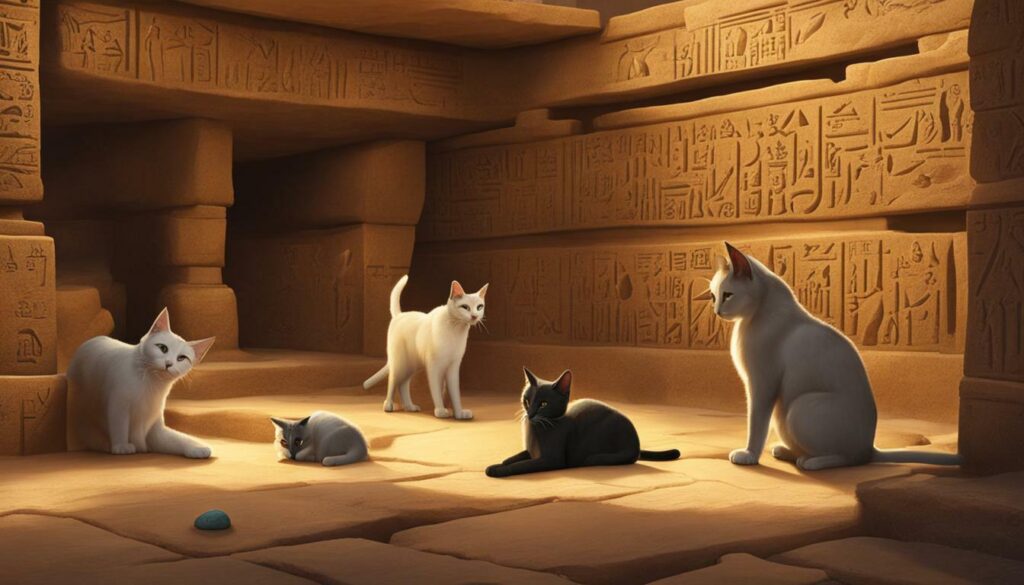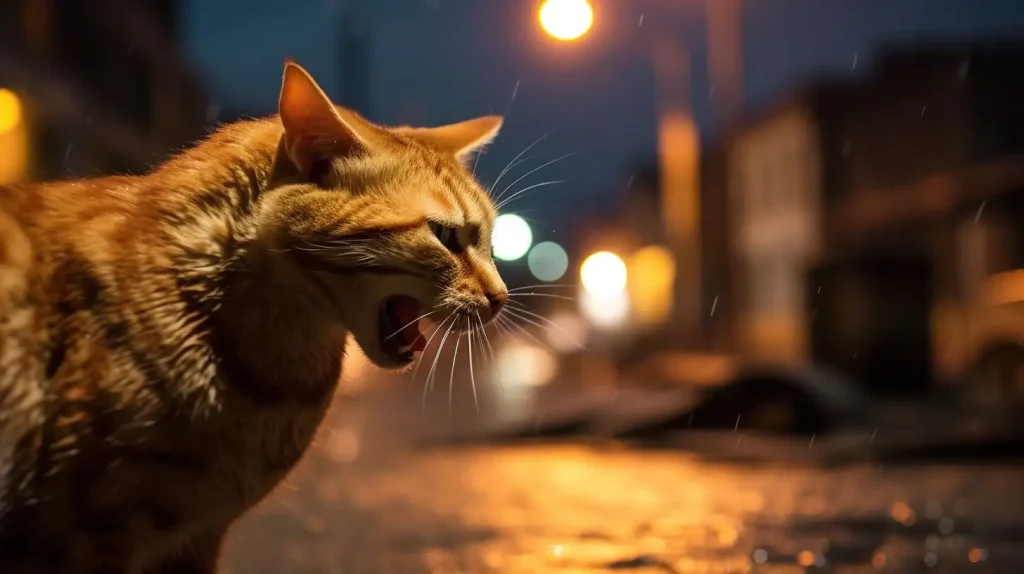Table of Contents
Cats have been fascinating creatures for humans since the dawn of time. Their elegant movements, sharp senses, and independent nature have captured the attention of people for centuries. But how did these wild creatures become the beloved household pets that we know today? The history of cat domestication is a journey that spans thousands of years and various civilizations.
Key Takeaways:
- The history of cat domestication dates back thousands of years.
- Cats have undergone a gradual transformation from wild predators to beloved household pets.
- The domestication of cats has shaped their behavior, characteristics, and roles in modern society.
The Early Relationship Between Humans and Cats
The story of cat domestication dates back over 10,000 years ago to the eastern Mediterranean region. Experts believe that the domestication of cats began as a way to control rodent populations that were attracted to early human settlements.
As humans began to cultivate crops and store grain, they inadvertently created the perfect environment for rodents to thrive. Cats, as natural predators, were attracted to the abundant prey and began to hunt them in exchange for food and shelter.
It is unclear when cats were first domesticated, but evidence suggests that wild cats were present in human settlements in ancient Egypt around 4000 BC. These cats were highly valued for their ability to protect food stores from rodents and poisonous snakes.
Over time, cats became a symbol of status and luxury in ancient Egypt, and they were often depicted in art and mythology. Many Egyptian households kept cats as beloved pets, and some were even given elaborate funerals upon their death.
The relationship between humans and cats spread throughout the world as people migrated and traded goods. Cats were brought to Europe by Phoenician traders and were quickly adopted by the Greeks and Romans. They played a significant role in Roman society, where they were considered a symbol of domesticity and prosperity.
The Origins of Domestic Cats
The origins of domestic cats are still somewhat of a mystery, as the process of domestication was likely a gradual one that occurred over thousands of years. However, it is believed that all domestic cats are descended from the African wildcat (Felis silvestris lybica), which is native to North Africa and the Near East.
Some experts believe that cats were first attracted to human settlements because of the availability of food and water, while others suggest that humans actively domesticated cats for their hunting abilities or companionship.
Despite the uncertainty surrounding their origins, it is clear that cats have played an important role in human history for thousands of years. From their early days as rodent hunters to their current status as beloved household pets, cats have proven to be loyal companions and valuable members of the human family.
Understanding the Evolutionary History of Cats
Cats have a long and fascinating evolutionary history that dates back millions of years. The modern domestic cat is believed to have originated from the African wildcat, a small wild feline that still roams the deserts and savannas of Africa and the Middle East today. This wildcat, scientifically known as Felis silvestris lybica, is considered to be the direct ancestor of all domestic cats.
Scientists believe that the African wildcat began to form a relationship with humans over 10,000 years ago, when humans started to settle and develop agriculture. As humans stored food, the wildcats were attracted to the rodents that were attracted to the food, leading to a mutually beneficial relationship.
Over time, humans began to recognize the value of these wildcats for their ability to control rodent populations and protect stored grain, leading to the domestication of cats. The domestication process took place over thousands of years, as humans selectively bred cats with desirable traits such as friendliness and tameness.
The evolutionary history of cats is marked by several key milestones, including the development of the saber-toothed tiger, which lived during the Pleistocene epoch and is believed to be one of the largest and most fearsome predators to have ever existed. Other significant feline ancestors include the ancient civet-like cats, which lived during the Eocene epoch and are believed to be the earliest known cats, as well as the prehistoric sabertooth cats and the American lion, which lived during the Pleistocene epoch.
Today, there are dozens of domestic cat breeds, each with its unique characteristics and traits. From Siamese cats to Maine Coons, cats have been an integral part of human civilization for thousands of years, serving as protectors, hunters, and beloved companions. With their long and storied evolutionary history, cats truly are one of the most fascinating creatures on the planet.
The Domestication of Cats: A Timeline
The domestication of cats is a gradual and fascinating process that took place over several millennia. While the exact timeline of cat domestication is still uncertain, researchers believe that it started around 10,000 years ago in the Near East.
During this time, humans were transitioning from a hunter-gatherer lifestyle to a more settled, agricultural one. They started to store grains, which attracted rodents, and as a result, wild cats were drawn to the settlements. These cats preyed on the rodents, providing a natural pest control service and forging an early bond with humans.
Over time, humans began to actively encourage the presence of cats in their homes and villages, providing them with food and shelter. This marked the beginning of a mutually beneficial relationship between cats and humans.
It is believed that the Ancient Egyptians were among the first to domesticate cats, around 4,000 years ago. They revered cats, portraying them in their art and even worshiping them as gods. Cats were highly valued, and killing one was considered a serious crime.
Throughout history, cats have been esteemed for their hunting abilities, their loyalty, and their companionship. Today, cats continue to be beloved pets all over the world and are bred in a wide variety of breeds with distinct characteristics and personalities.
The domestication of cats has been a long and complex process that has shaped the relationship between cats and humans. From their humble beginnings as wild predators to their current role as beloved household pets, cats have come a long way. With their unique personalities and behaviors, cats continue to captivate and fascinate us.
Ancient Cat Breeds and Cultural Significance
Throughout history, cats have played an important role in various cultures and have been revered as symbols of status, protection, and companionship. Ancient cat breeds were often kept for their ability to hunt pests or as ritualistic symbols in religious ceremonies.
Egyptian civilization holds the distinction of being the first to domesticate cats, approximately 4,000 years ago. The Egyptian Mau, one of the oldest known cat breeds, was considered sacred and revered for its hunting skills. It was often depicted in ancient Egyptian artwork and was highly valued for its ability to ward off pests like rodents and snakes.
| Ancient Cat Breeds | Country of Origin | Cultural Significance |
|---|---|---|
| Siamese | Thailand | Considered a sacred cat and was often housed in temples. |
| Persian | Iran | Considered a symbol of luxury and status. |
| Sphynx | Canada | Known for being a hairless cat breed, it has been used in modern-day advertising and films. |
Other ancient cat breeds include the Turkish Angora, which originated in Turkey and was known for its silky white fur, and the Japanese Bobtail, which was bred for its short, stubby tail and was considered a symbol of good luck.
As time passed, cats became more than just useful hunting and pest control companions. They evolved to become beloved household pets, providing their owners with emotional support and companionship. The transition from ancient cat breeds to modern-day domestic cat breeds is a fascinating journey that showcases the evolving relationship between humans and cats.
The Modern-Day Cat: From Hunter to Household Pet
Domestication of wild cats has transformed these fierce predators into loving household pets. Feline domestication facts show that humans began taming wild cats as early as 7500 BCE, when cats were first attracted to settlements in the Middle East in search of food. While the early cats were primarily kept to control rodents, they gradually became valued companions, appreciated for their affectionate nature and companionship.
As cats evolved from wild animals to pets, their behavior and characteristics changed. Domesticated cats are now more docile, friendly, and less aggressive than their wild ancestors. They’ve also developed physical traits that are more suitable for indoor living, such as softer fur and smaller size. With their hunting instincts intact, they still love to play and chase toys, but they are highly adaptable and can now thrive in a variety of environments.
The domestication process has also affected the roles of cats in modern society. Today, cats are more commonly kept as pets than for their hunting prowess. They are cherished members of families and are often treated more like children than animals. They provide comfort, companionship, and emotional support to their owners, making a significant positive impact on mental health.
In conclusion, the domestication of wild cats has not only transformed their physical traits and behavior but also their roles in society. While they may have started as rodent hunters, they have now become beloved household pets who offer love, comfort, and joy to millions of people around the world.
The History of Cats and Domestication
The history of cats and domestication dates back thousands of years. Cats were originally wild predators, but over time, they became beloved household pets. This article explored the fascinating journey of cats from their earliest origins to the modern-day, exploring their relationship with humans and the cultural significance of various ancient cat breeds.
The Enduring Bond Between Cats and Humans
Through the centuries, cats have proven themselves to be valuable companions to humans. From ancient civilizations to modern times, cats have served as symbols of prestige, protection, and companionship. Today, millions of people around the world keep cats as pets, and the bond between cats and humans remains as strong as ever.
The Evolutionary History of Cats
Domestic cats are believed to have descended from a wild ancestor called the African wildcat. The process of domestication began thousands of years ago, as cats began to enter human settlements in search of food and shelter. Over time, humans began to recognize the value of cats as hunters of vermin, and they began to selectively breed cats for specific traits.
The Domestication of Cats
The domestication of cats was a gradual process that took place over thousands of years. It involved the selective breeding of cats for specific traits, such as coat color and temperament. Today, there are many different breeds of domestic cats, each with their own unique characteristics.
Ancient Cat Breeds and Cultural Significance
Ancient cat breeds played an important role in many different cultures throughout history. In ancient Egypt, for example, cats were revered as sacred animals and were often depicted in artwork. In other cultures, cats were valued for their hunting skills and were kept as working animals.
The Modern-Day Cat
Today, cats are a ubiquitous presence in households around the world. They are valued for their companionship, their affectionate nature, and their ability to keep pests at bay. Despite their long history of domestication, cats still retain many of their wild instincts, and they are capable hunters and predators.
Conclusion
The history of cats and domestication is a fascinating subject that sheds light on the enduring bond between cats and humans. From their earliest origins to the present day, cats have played an important role in human society, serving as companions, protectors, and even symbols of power. The history of cats and domestication is a testament to the enduring appeal of these beloved creatures.



